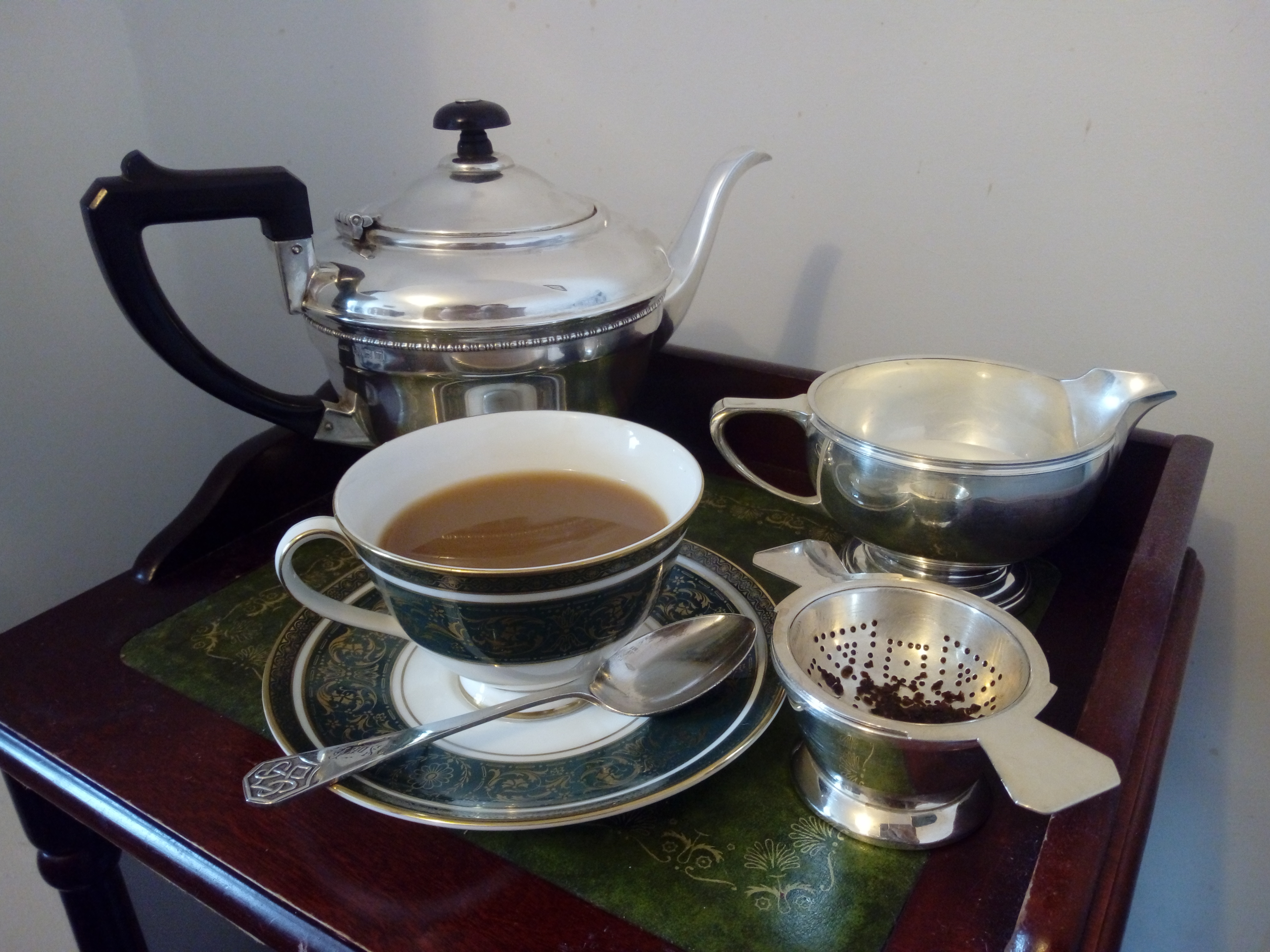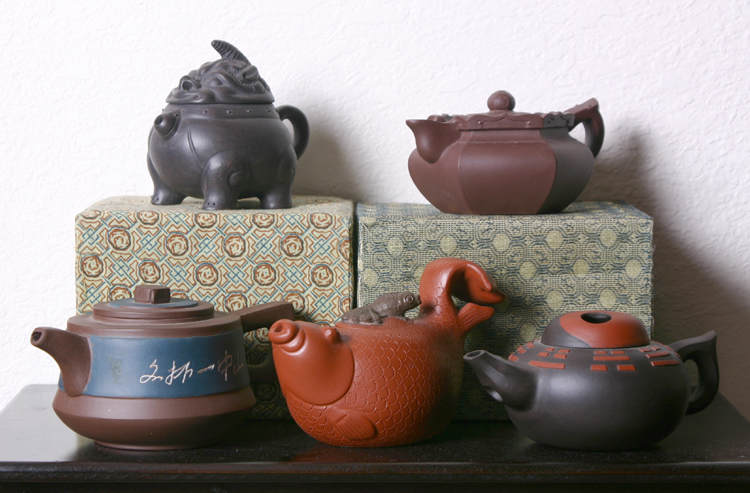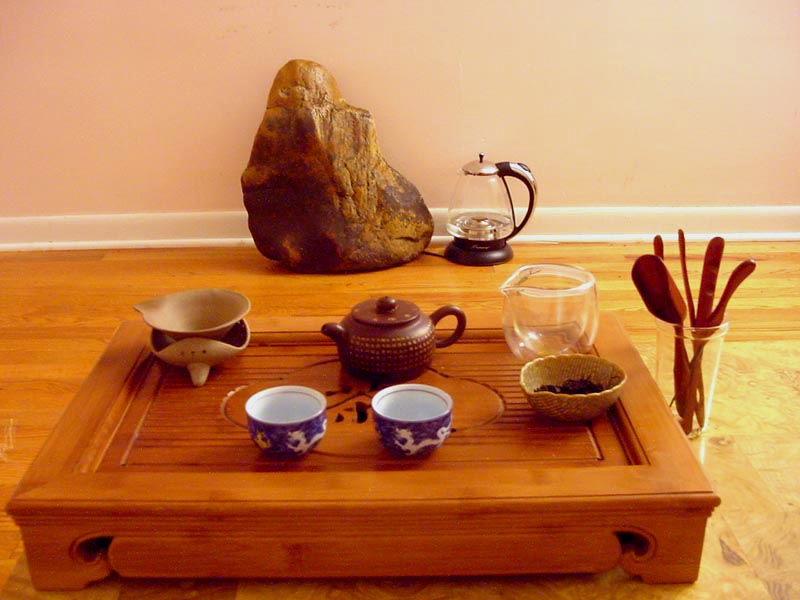|
Teapot
A teapot is a vessel used for steeping tea leaves or a herbal mix in boiling or near-boiling water, and for serving the resulting infusion which is called tea. It is one of the core components of teaware. Dry tea is available either in tea bags or as loose tea, in which case a tea infuser or tea strainer may be of some assistance, either to hold the leaves as they steep or to catch the leaves inside the teapot when the tea is poured. Teapots usually have an opening with a lid at their top, where the dry tea and hot water are added, a handle for holding by hand and a spout through which the tea is served. Some teapots have a strainer built-in on the inner edge of the spout. A small air hole in the lid is often created to stop the spout from dripping and splashing when tea is poured. In modern times, a thermally insulating cover called a tea cosy may be used to enhance the steeping process or to prevent the contents of the teapot from cooling too rapidly. History China ... [...More Info...] [...Related Items...] OR: [Wikipedia] [Google] [Baidu] |
Tea Cosy
A tea cosy or tea warmer is a cover for a teapot,Article of the'' Boston Journal'', 25 November 1879 traditionally made of cloth. It insulates a teapot, keeping the contents warm. Their use predates the invention of vacuum flasks as a means of keeping hot liquids hot. Sometimes, if the tea is served in a restaurant or in a hotel, the teapot is covered with a tea cosy that has a metal exterior to protect the inner fabric of the cosy from wear and tear and also to further improve the insulation of the teapot. A typical cosy is easy to put over or pop off the teapot in order to pour the tea, but some are wrapped around the teapot and have holes for the spout and the handle (so called "bachelor" teapots). The "crinoline lady" cosies include a porcelain doll on the top, with her flowing skirts providing the thermal insulation. Tea cosies may have padded inserts that can be removed and washed. Some tea cosies are hand- knitted, resembling woollen hats, some even feature a "bobble ... [...More Info...] [...Related Items...] OR: [Wikipedia] [Google] [Baidu] |
Celadon
''Celadon'' () is a term for pottery denoting both wares glazed in the jade green celadon color, also known as greenware or "green ware" (the term specialists now tend to use), and a type of transparent glaze, often with small cracks, that was first used on greenware, but later used on other porcelains. Celadon originated in China, though the term is purely European, and notable kilns such as the Longquan kiln in Zhejiang province are renowned for their celadon glazes. Celadon production later spread to other parts of East Asia, such as Japan and Korea as well as Southeast Asian countries such as Thailand. Eventually, European potteries produced some pieces, but it was never a major element there. Finer pieces are in porcelain, but both the color and the glaze can be produced in stoneware and earthenware. Most of the earlier Longquan celadon is on the border of stoneware and porcelain, meeting the Chinese but not the European definitions of porcelain. For many centuries ... [...More Info...] [...Related Items...] OR: [Wikipedia] [Google] [Baidu] |
Teaware
Teaware is a broad international spectrum of equipment used in the brewing and consumption of tea. Many components make up that spectrum, and vary greatly based upon the type of tea being prepared, and the cultural setting in which it is being prepared. This is often referred to as the ''tea ceremony,'' and holds much significance in many cultures, particularly in northwestern Europe and in eastern Asia. A complete, cohesive collection of tea ware makes up a tea set. Components Alternatives / Others * Mug, instead of tea cup *Coffee cup, instead of tea cup * Chawan, tea bowl from East Asia *Chaki, the caddy for matcha * Japanese tea utensils, used in their tea ceremonies *Tea draining tray, for the Gongfu tea ceremony Construction Tea equipment may be constructed of many materials, from iron in Japan to porcelain and clay in China, and also bamboo and other woods. Of particular repute are the Yixing clay teapots produced in eastern China, a type of Yixing ware. The B ... [...More Info...] [...Related Items...] OR: [Wikipedia] [Google] [Baidu] |
Black Tea Pot Cropped
Black is a color which results from the absence or complete absorption of visible light. It is an achromatic color, without hue, like white and grey. It is often used symbolically or figuratively to represent darkness. Black and white have often been used to describe opposites such as good and evil, the Dark Ages versus Age of Enlightenment, and night versus day. Since the Middle Ages, black has been the symbolic color of solemnity and authority, and for this reason it is still commonly worn by judges and magistrates. Black was one of the first colors used by artists in Neolithic cave paintings. It was used in ancient Egypt and Greece as the color of the underworld. In the Roman Empire, it became the color of mourning, and over the centuries it was frequently associated with death, evil, witches, and magic. In the 14th century, it was worn by royalty, clergy, judges, and government officials in much of Europe. It became the color worn by English romantic poets, ... [...More Info...] [...Related Items...] OR: [Wikipedia] [Google] [Baidu] |
Yuan Dynasty
The Yuan dynasty (), officially the Great Yuan (; xng, , , literally "Great Yuan State"), was a Mongols, Mongol-led Dynasties in Chinese history, imperial dynasty of China and a successor state to the Mongol Empire after Division of the Mongol Empire, its division. It was established by Kublai Khan, Kublai, the fifth khagan-emperor of the Mongol Empire from the Borjigin clan, and lasted from 1271 to 1368. In orthodox Chinese historiography, the Yuan dynasty followed the Song dynasty and preceded the Ming dynasty. Although Genghis Khan had been enthroned with the Han Chinese, Han-style title of Emperor of China, Emperor in 1206 and the Mongol Empire had ruled territories including modern-day Northern and southern China, northern China for decades, it was not until 1271 that Kublai Khan officially proclaimed the dynasty in the traditional Han style, and the conquest was not complete until 1279 when the Southern Song dynasty was defeated in the Battle of Yamen. His realm was, ... [...More Info...] [...Related Items...] OR: [Wikipedia] [Google] [Baidu] |
Yixing Ware
Yixing clay () is a type of clay from the region near the city of Yixing in Jiangsu Province, China, used in Chinese pottery since the Song dynasty (960–1279) when Yixing clay was first mined around China's Lake Tai. From the 17th century on, Yixing wares were Chinese export porcelain, commonly exported to Europe. The finished stoneware, which is used for teaware and other small items, is usually red or brown in colour. Also known as zisha () ware, they are typically left ceramic glaze, unglazed and use clays that are very cohesive and can form coils, slabs and most commonly slipcasting, slip casts. These clays can also be formed by throwing. The best known wares made from Yixing clay are Yixing clay teapots, tea pets, and other teaware. Clay types Zisha can be broadly categorised into three main colour: purple, red and beige: *''Purple: Zi sha'' or ''zi ni'' (紫砂 or 紫泥; literally, "purple sand/clay"): this stoneware has a purple-red-brown colour. *''Red: Zhu sha'' ... [...More Info...] [...Related Items...] OR: [Wikipedia] [Google] [Baidu] |
Gongfu Tea Ceremony
The gongfu tea ceremony or kung fu tea ceremony ( or ), is a type of Chinese tea ceremony, involving the ritual preparation and presentation of tea. It is probably based on the tea preparation approaches originated in Fujian and the Chaoshan area of eastern Guangdong. The term literally means "making tea with skill". The approach often involves using smaller brewing vessels and a higher leaf-to-water ratio than in western-style brewing. Today, the approach is used popularly by teashops carrying tea of Chinese origins, and by tea connoisseurs as a way to maximize the taste of a tea selection, especially a finer one. History Attention to tea-making quality has been a classic Chinese tradition. All teas, loose tea, coarse tea, and powdered tea have long coexisted with the "imperially appointed compressed form". By the end of the 14th century, the more naturalistic "loose leaf" form had become a popular household product and by the Ming era, loose tea was put to imperial use. Th ... [...More Info...] [...Related Items...] OR: [Wikipedia] [Google] [Baidu] |
Flagstaff House Museum Of Teaware
Flagstaff House, built in 1846, is the oldest example of Western-style architecture remaining in Hong Kong.Antiquities and Monuments OfficeDeclared Monuments in Hong Kong: Flagstaff House It is located at 10 Cotton Tree Drive, Central – within the Hong Kong Park. It has been a longtime residence of the Commander of the British forces in Hong Kong during colonial times. Today Flagstaff House houses the Museum of Tea Ware. History Flagstaff House had been named as Headquarter House until 1932.Eric CavalieroProud house on a hill, The Standard, 16 January 1997 The site chosen was a small bluff above the barracks and above Queen's Road, then at the waterfront. The building was designed in Greek revival style. Historians suspect it was designed either by Murdoch Bruce, a Scotsman who was inspector of buildings, or by Lieutenant Bernard Collinson of the Royal Engineers. The first occupant was Major-General George Charles D'Aguilar, General Officer Commanding from 1844 ... [...More Info...] [...Related Items...] OR: [Wikipedia] [Google] [Baidu] |
Yixing Ware
Yixing clay () is a type of clay from the region near the city of Yixing in Jiangsu Province, China, used in Chinese pottery since the Song dynasty (960–1279) when Yixing clay was first mined around China's Lake Tai. From the 17th century on, Yixing wares were Chinese export porcelain, commonly exported to Europe. The finished stoneware, which is used for teaware and other small items, is usually red or brown in colour. Also known as zisha () ware, they are typically left ceramic glaze, unglazed and use clays that are very cohesive and can form coils, slabs and most commonly slipcasting, slip casts. These clays can also be formed by throwing. The best known wares made from Yixing clay are Yixing clay teapots, tea pets, and other teaware. Clay types Zisha can be broadly categorised into three main colour: purple, red and beige: *''Purple: Zi sha'' or ''zi ni'' (紫砂 or 紫泥; literally, "purple sand/clay"): this stoneware has a purple-red-brown colour. *''Red: Zhu sha'' ... [...More Info...] [...Related Items...] OR: [Wikipedia] [Google] [Baidu] |
Jun Ware
Jun ware () is a type of Chinese pottery, one of the Five Great Kilns of Song dynasty ceramics. Despite its fame, much about Jun ware remains unclear, and the subject of arguments among experts. Several different types of pottery are covered by the term, produced over several centuries and in several places, during the Northern Song dynasty (960–1127), Jin dynasty (1115–1234) and Yuan dynasty (1271–1368), and (as has become clearer in recent years) lasting into the early Ming dynasty (1368–1644). Some of the wares were for a popular market, especially the drinking vessels, but others seem to have been made for the imperial court and are known as "official Jun wares"; they are not mentioned in contemporary documents and their dating remains somewhat controversial. These are mostly bowls for growing bulbs or flower-pots with matching stands, such as can be seen in many paintings of scenes in imperial palaces. The consensus that seems to be emerging, driven largely ... [...More Info...] [...Related Items...] OR: [Wikipedia] [Google] [Baidu] |
Ming Dynasty
The Ming dynasty (), officially the Great Ming, was an Dynasties in Chinese history, imperial dynasty of China, ruling from 1368 to 1644 following the collapse of the Mongol Empire, Mongol-led Yuan dynasty. The Ming dynasty was the last orthodox dynasty of China ruled by the Han Chinese, Han people, the majority ethnic group in China. Although the primary capital of Beijing fell in 1644 to a rebellion led by Li Zicheng (who established the short-lived Shun dynasty), numerous rump state, rump regimes ruled by remnants of the House of Zhu, Ming imperial family—collectively called the Southern Ming—survived until 1662. The Ming dynasty's founder, the Hongwu Emperor (r. 1368–1398), attempted to create a society of self-sufficient rural communities ordered in a rigid, immobile system that would guarantee and support a permanent class of soldiers for his dynasty: the empire's standing army exceeded one million troops and the naval history of China, navy's dockyards in Nanjin ... [...More Info...] [...Related Items...] OR: [Wikipedia] [Google] [Baidu] |








_LACMA_M.73.48.132.jpg)
